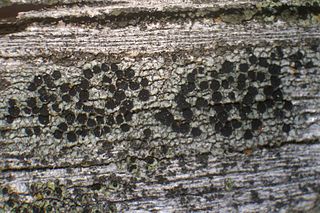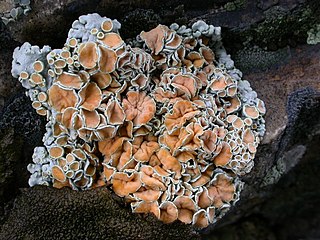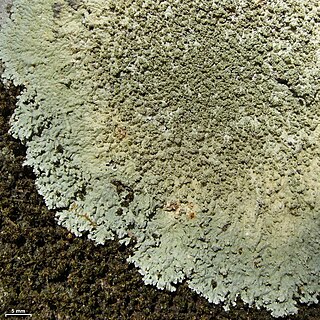
Acarospora is a genus of mostly lichen-forming fungi in the family Acarosporaceae. Most species in the genus are crustose lichens that grow on rocks in open and arid places all over the world. They may look like a cobblestone road or cracked up old paint, and are commonly called cobblestone lichens or cracked lichens. They usually grow on rock, but some grow on soil (terricolous) or on other lichens. Some species in the genus are fungi that live as parasites on other lichens. Acarospora is a widely distributed genus, with about 128 species according to a 2008 estimate.

Buellia is a genus of mostly lichen-forming fungi in the family Caliciaceae. The fungi are usually part of a crustose lichen. In this case, the lichen species is given the same name as the fungus. But members may also grow as parasites on lichens (lichenicolous). The algae in the lichen is always a member of the genus Trebouxia.
Lecidea hassei is an endolithic lichen that appears as tiny black, gray rimmed, plate-like or crinkled discs between crystals of rock in California. The main body grows inside solid rock (endolithic), and the crinkled discs above the rock surface are the sexual reproduction structures. It is endemic to California, where it only grows in the lower montane belt, including in deserts and chaparral. It occurs in Joshua Tree National Park. The sexual reproduction structures (apothecia) are black, thinly rimmed with unpigmented fungal tissue surrounding black discs in the middle, and up to 2.2 mm in diameter. They rise out of the rock in a flat to convex disc with a constricted base, giving the appearance of tiny raised plates. It grows in open areas on granite, schist, and other acidic rock. It resembles Lecidea laboriosa but produces schizopeltic acid as a metabolite, instead of 4-O-demethyl planaic acid. The species epithet honors H.E. Hasse, who wrote the 1913 "Lichen Flora of Southern California". Lichen spot tests are negative on both the cortex and medulla.
Xanthoparmelia maricopensis, the Maricopa rock-shield, is a 2–6 cm (0.8–2.4 in) wide, yellow-green foliose lichen in the Parmeliaceae family. It grows on igneous rock in southwestern North American deserts.

Lecanora muralis(Protoparmeliopsis muralis) is a waxy looking, pale yellowish green crustose lichen that usually grows in rosettes radiating from a center (placodioid) filled with disc-like yellowish-tan fruiting bodies (apothecia). It grows all over the world. It is extremely variable in its characteristics as a single taxon, and may represent a complex of species. The fruiting body parts have rims of tissue similar to that of the main nonfruiting body (thallus), which is called being lecanorine. It is paler and greener than L. mellea, and more yellow than L. sierrae. In California, it may be the most common member of the Lecanora genus found growing on rocks (saxicolous).

Xanthoparmelia mexicana, commonly known as the salted rock-shield, is a foliose lichen in the family Parmeliaceae. It grows in 4–10 cm diameter rosettes of gray-green to yellow-green lobes in arid climates all over the world.

Aspicilia phaea is a grayish brown to tan areolate crustose lichen commonly found on rock in coastal to inland parts of central and southern California. Described as new to science in 2007, it is endemic to California. It grows on exposed or partially shaded siliceous rock, with a few known occurrences on serpentine rock.

Rhizoplaca chrysoleuca is a pale yellowish-green to gray-green umbilicate foiliose lichen in the Lecanoraceae family. It was first described in 1791 by English botanist Sir James Edward Smith as Lichen chrysoleucus; Friedrich Wilhelm Zopf transferred it to the genus Rhizoplaca in 1905.

Candelariella vitellina is a common and widespread green-yellow to orange-yellow crustose areolate lichen that grows on rock, wood, and bark, all over the world. It grows on non-calcareous rock, wood, and bark.

Lobothallia alphoplaca, the variable sunken disk lichen, is a creamy gray to brown, placodioid areolate lichen that grows on rock in on rock and sometimes moss. It prefers growing on siliceous rocks. It is found in Europe, central Asia, and North America, where it grows in the southwestern deserts to central California. The center has numerous crowded and deformed apothecia with rims of thallus-like tissue (lecanorine). With dark reddish or grayish brown to black discs. Lichen spot tests on the thallus and apothecia are C−, and KC−, with tests on the cortex K+ red, P+ orange, or K−, P− and on the medulla K+ red, and P+ orange. It produces norstictic acid, constictic acid, or salazinic acid as secondary metabolites.
Aspicilia californica is a small white to white mottled gray or gray-green foliose lichen, with stringy, terete, branch-like lobes. It is endemic to central and southern California, that grows on organic debris, moss, and rock in chaparral habitats. It attaches to the substrate at several points along the branch-like lobes. It may form areoles when growing on more solid substrates. Apothecia are rare. Lichen spot tests on the cortex and medulla are K+ red, KC−, C−, + orange, and I−. The olive brown Aspicilia filiformis is another fruticose species in this mostly crustose genus, occurring in Oregon, Idaho, Utah, Washington and Montana, with one known location also in California.
Thomas Hawkes Nash III is an American lichenologist. His research is about the biology and ecology of lichens, and the effects of air pollution on plants and lichens. He is known as an authority on the family Parmeliaceae. During his long career at the Arizona State University, he helped develop the lichen herbarium into a world-class collection with over 100,000 specimens representing more than 5000 species. In 2010, the year of his retirement, he was awarded the Acharius Medal for lifetime achievements in lichenology, and the following year had a Festschrift published in his honor.
Punctelia cedrosensis is a species of foliose lichen in the family Parmeliaceae. It is endemic to Mexico, where it grows on the bark of conifers.

Candelaria pacifica is a widely distributed corticolous (bark-dwelling), leprose lichen. It was formally described as a species in 2011.

Dirinaria aegialita is a species of foliose lichen in the family Caliciaceae. It is found in tropical regions around the world, with scattered occurrences in subtropical North America.
Dirinaria neotropica is a species of lichen belonging to the genus Dirinaria within the family Caliciaceae. It was described by Kalb in 2004.

Dirinaria confluens is a species of foliose lichen belonging to the genus Dirinaria within the family Caliciaceae. It was originally described by D.D.Awasthi in 1975.

Dirinaria confusa is a species of fungus within the family Caliciaceae, belonging to the order Caliciales in the class Lecanoromycetes of the division Ascomycota.

Dirinaria picta is a species of lichen within the family Caliciaceae, classified under the order Caliciales in the class Lecanoromycetes of the division Ascomycota.

Buellia aethalea is a species of lichen that belongs to the family Caliciaceae. It is commonly known as darkened button lichen, and Buellie noircie in French.














